Abstract
This exposition is not intended to be a scientific or theological treatise, but rather a testimony to a personal call by Padre Pio, a commitment in faith, to duplicate St. Pio's model of healthcare delivery as a “Beacon of Light” in our increasingly secular country, an example of truly faithful Catholic health care fully faithful to the Magisterial authority of the Church, and a model for other Catholic hospitals to emulate in their ministries.
Keywords: Padre Pio, Casa USA, Catholic healthcare, St. Pio, Casa Sollievo della Sofferenza, Home for the Relief of Suffering, Padre Pio Prayer Groups, Raymond Cardinal Burke
Introduction
Love is the first ingredient to the relief of suffering.—Padre Pio
There is little debate that the delivery of Catholic health care in the United States has undergone an extended period of painful transition for at least three decades, as health system leadership struggles with the conflicting tensions of moral values that differ between Church and society. Many, if not most, Catholic healthcare systems have entertained structures and partnerships that directly or indirectly compromise the teachings and directives of the Magisterial authority of the Catholic Church in order to enhance security, financial benefit, or stability. Christians are all too familiar with Christ's call to childlike faith, “Amen, I say to you, unless you turn and become like children, you will not enter the kingdom of heaven” (Mt 18:3). Yet to incorporate that principle into life and business practice is not as easy as it may seem. Ironically, childlike faith was the catalyst for most religiously based hospital systems as they sprang into being, and their stories are all too similar: A handful of consecrated religious men or women answered the call with childlike faith to venture to the New World, with few or no resources, to care for those in need. That is without question the definition of childlike faith. And as He has constantly promised, God responded faithfully to bless this unwavering faith by showering abundant graces upon these new ministries and apostolates along with great success and prosperity. Many of these “mustard seeds” of faith have blossomed into multi-billion dollar regional and national healthcare systems. This is a testimony to the faithfulness of God's promises over and over again throughout history, that if we follow His way, He will prosper our work:
Trust in the LORD with all your heart, on your own intelligence do not rely; In all your ways be mindful of him, and he will make straight your paths. Do not be wise in your own eyes, fear the LORD and turn away from evil; … Then will your barns be filled with plenty, with new wine your vats will overflow. (Prov 3: 5–7, 10)
Unfortunately, when ministry seeds grow into large systems with multiple facilities, thousands of employees, and large operating budgets and responsibilities, the leadership focus tends to evolve from willingness to take risks based on inspiration to fiscal stewardship. This tendency is exacerbated when complicated by uncertain futures due to shrinking reimbursement and revenues, rapidly growing governmental regulation and oversight, and confusing social tensions. The natural result is large multi-billion dollar systems operating in fear of losing what they have accumulated … not proceeding in childlike faith, inspiration of the Holy Spirit, or on the foundational values established by the centuries-old Magisterial teachings of the Church. Confused by all of this, system leaderships become perplexed as their resources and prosperity dwindle. Even the beautiful presence of holy religious men and women, so familiar in the Catholic hospitals of the past, have all but disappeared due to record reductions in religious vocations. Then we begin to hear sad debates among both religious leaders and the faithful regarding whether a truly faithful Catholic healthcare system can survive in this secular society, and if this society will ever produce the vocations of centuries past.
This is the current state of Catholic health care in the United States. Systems that identify themselves as Catholic constitute the largest nonprofit healthcare network in the country (CHAUS 2016), and united together and with the bishops they could define the platform, principles, and values upon which health care is delivered throughout this country. However, in nearly scandalous fashion, this influential Catholic healthcare network operates with great fragmentation and often in opposition to the leadership of the bishops. St. (Padre) Pio has provided a glowing example of the true meaning of the continuation of Christ's healing ministry with the development of his Home for the Relief of Suffering in San Giovanni Rotondo, Italy. This 1,000-bed regional medical center, owned by the Holy See, was built upon childlike faith and steadfast loyalty to the Magisterium of the Catholic Church. Faith and loyalty continue as guiding principles as it thrives in its sixtieth year of providing relief of suffering to those in need in one of the most remote and underserved regions of Italy.
This exposition is not intended to be a scientific or theological treatise, but rather a testimony to a personal call by Padre Pio, a commitment in childlike faith, to duplicate St. Pio's model of healthcare delivery as a beacon of light in our increasingly secular country—an example of truly faithful Catholic health care, fully faithful to the Magisterial authority of the Church, and a model for other Catholic hospitals to emulate in their ministries.
About Padre Pio
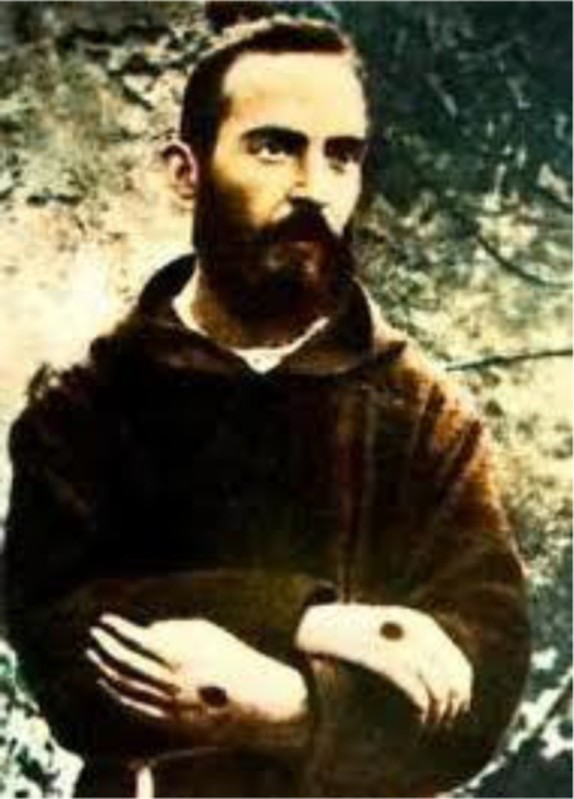
Padre Pio was born on May 25, 1887, in Pietrelcina, Italy, and baptized with the name Francesco Grazio. From his early childhood he was visited regularly by his guardian angel and the Blessed Virgin Mary. He did not think this was unusual until a young friend told him otherwise. He was ordained a priest in the Capuchin Order on August 10, 1910. His young priestly life was marked by numerous episodes of poor health, and also included a short stint with the military. After being discharged from the army in 1918, he was stationed at the remote monastery at San Giovanni Rotondo, never to leave until his death. On December 20, 1918, he was blessed with the extraordinary visible stigmata of Christ (5 wounds on his hands, feet, and side). His priestly ministry was characterized by humility, perseverance, and obedience to his priestly duties, especially to the celebration of Mass, hours in the confessional, and spiritual direction. He was able to read the hearts of many who came to him for confession, often reminding them of unconfessed sins and foretelling future occurrences in their lives and God's will for them. A huge international cult rose up around Padre Pio, manifesting itself in constant crowds of pilgrims to the monastery to attend his Masses and to confess to him.
Padre Pio was a man of prayer, pain, and suffering, and dedicated his life to the relief of Jesus’ suffering children. The number of lives changed through his intercession in incalculable. He died in the fiftieth year of his stigmata, on September 23, 1968, at the age of 81. His legacy lives on through the international prayer groups and the “Work” of the Casa in Italy. Padre Pio was beatified by Pope John Paul II in May 2000, and was canonized as a saint of the Church in June 2002.
Development of the Home for the Relief of Suffering
This Work, if it were only to be the relief of bodily suffering,
would only be a model clinic, built through your charity.
Here, patients, doctors and priests will be reserves of love, which,
the more it is abundant in one, the more it will be communicated to all.—Padre Pio
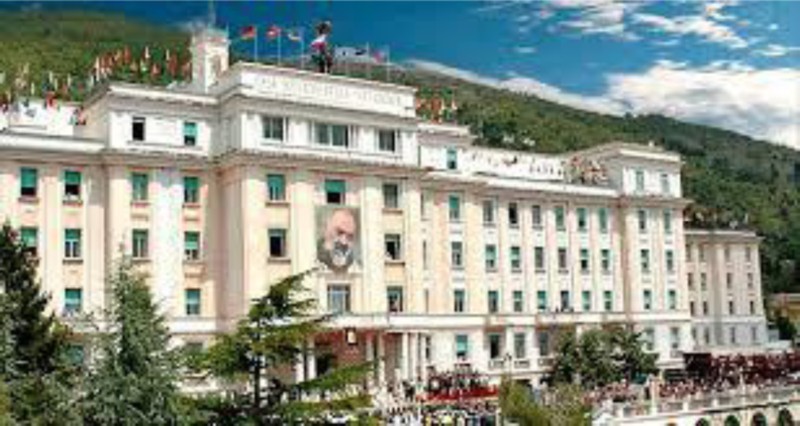
On January 9, 1940, Padre Pio announced his grandiose plans to develop a Home for the Relief of Suffering (the Casa Sollievo della Sofferenza) (“A short biography” 2009, 12), to serve the healthcare needs of the people of San Giovanni Rotondo, numbering approximately four thousand at the time. The Casa opened its doors on May 5, 1956, as a 300-bed facility, built on the small, sincere, and spontaneous donations and prayers of his followers. He also developed an international network of prayer groups for the support of the Casa and its ministry which continues to live on and grow today. Padre Pio considered the Casa Sollievo Della Sofferenza (Casa) his primary “Work” on earth, inspired and blessed by God to be a haven of relief from suffering for all of God's children in pain in body or soul. It is a model community of Catholic, Christian health delivery, and has grown into a regional referral center of international renown. Today, with over one thousand beds and services comparable to most academic research centers of excellence, the Casa is thriving by God's graces in one of the most remote, desolate, and poorest areas of Italy—atop Mount Gargano, four hours from Rome.
In his last will and testament, and in order to insure its continued faithfulness to the Magisterium of the Catholic Church, Padre Pio left the Casa to the ongoing stewardship of the Holy See. Currently, the Secretary of State of the Vatican is ultimately responsible for the Foundation that provides leadership for the Casa Sollievo della Sofferenza and its many affiliated entities.
Padre Pio Prayer Groups
It is to prayer that I entrust the Work, which God has wished
and which will continue to progress and prosper thanks to the help of Divine Providence
and the charitable and spiritual contribution of all those who pray.—Padre Pio
Padre Pio was firmly convicted that the success of the Casa relied upon a strong foundation of prayer. Prior to commencing its construction, he instituted a formal international network of prayer groups to support this apostolate (Leone 1986). Today there are over three thousand formally approved Padre Pio Prayer Groups in sixty-five countries, with over 125 prayer groups in the United States under the leadership of Fr. Francis Sariego, OFM Cap., the national coordinator, in Wilmington, Delaware (Padre Pio Prayer Groups USA 2016). These prayer warriors continue to provide essential support to the Casa and all of its initiatives, including those considered in this article in the United States.
The Crisis in Catholic Healthcare Delivery
The whole of humankind is called to collaborate in this apostolate
to help human suffering so that all may feel the stimulus of the Spirit;
they will have from Jesus the Glory which His Father gave to Him.—Padre Pio
Society in the United States, and in most Western nations, is trending rapidly toward secularization, moral relativism, and often an anti-Christian bias. This ideology drives the philosophy and values of many of our governmental leaders and the legislation and regulations they pursue. In recent years this has manifested itself directly in several impactful ways: The US Department of Health and Human Services contraceptive mandate, the compromising principles embedded within the Affordable Care Act (Obamacare), the battle against conscience protection, legalization of abortion, physician-assisted suicide, etc. Many faithful Christians would argue that our society is evolving under the direction of a misguided moral compass, and confused and conflicted foundational values.
We are of course a fallen race from the time of the first sin, and it is not unusual throughout salvation history for society to become misguided in its pursuits. In times like these, we look to the Magisterial leadership to provide guidance to refocus the faithful back to the Truth. This becomes confusing to the faithful when large and powerful Catholic associations promote positions contrary to those of the Magisterium. This is precisely what happened at the eleventh hour of the congressional approval process when the Catholic Health Association (a professional association of over six hundred Catholic hospitals and healthcare systems) and the Leadership Conference of Women Religious (representing 59,000 Catholic religious women) directly defied the clear counsel of the United States Conference of Catholic Bishops (USCCB) and formally endorsed the Affordable Care Act (Obamacare). This type of conflict confuses the faithful regarding the truth, creates a visibly public scandal for the Church, and opens the door to misinterpretation and controversy regarding the truth about Church teaching and its position on specific issues. Never was this more in evidence than on June 9, 2015, when addressing the Catholic Health Association's (CHA) one hundredth anniversary annual congress as its keynote speaker, President Obama said the following:
Well, I don't know whether this is appropriate, but I just told Sister Carol I love her. On a big stage. It is true, though -- I do. She is just wonderful. We would not have gotten the Affordable Care Act done had it not been for her. I want to thank the entire Catholic Health Association for the incredible work you do. (Obama 2015)
Long established Catholic healthcare systems are even formally forfeiting their Catholic identity and changing their names so that they are free to pursue structures and arrangements contrary to the Ethical and Religious Directives of the US Conference of Catholic Bishops (USCCB 2009). This is all a very disturbing trend and a scandal at the highest level for the Church in the US and Catholic healthcare delivery in this country. It is also the foundation for the clarion call for the remaining faithful Catholic religious and healthcare leaders to direct the way to a return to faithfulness to the Magisterium in the delivery of Catholic healthcare in this country and throughout the world. “Then I heard the voice of the Lord saying,” “Whom shall I send? Who will go for us?” “Here I am,” I said; “send me!” (Isa 6:8).
Formal Collaboration Agreement
In July 2004, moved by these unsettling trends and inspired by the charism of St. Pio of Pietrelcina, a small group of concerned Catholic healthcare and religious leaders came together and formed the nonprofit corporation Catholic Healthcare International (CHI). The vision of CHI was articulated decades earlier in 1950, six years before the opening of the Casa, by Dr. Guglielmo Sanguinetti. Dr. Sanguinetti was a founder and the Director of Implementation of the Casa, handpicked by Padre Pio, and he is quoted in the July 1950 issue of La Casa Sollievo della Sofferenza as saying:
The Casa Sollievo della Sofferenza should therefore be the first link in a great chain. It should be the model for many other innumerable Casa's with the same name and above all the same spirit, which must bring love to all of humanity. A program which would make us tremble with awe, if it was not inspired by God who is, above all, love! (La Casa Sollievo della Sofferenza newsletter 1950)
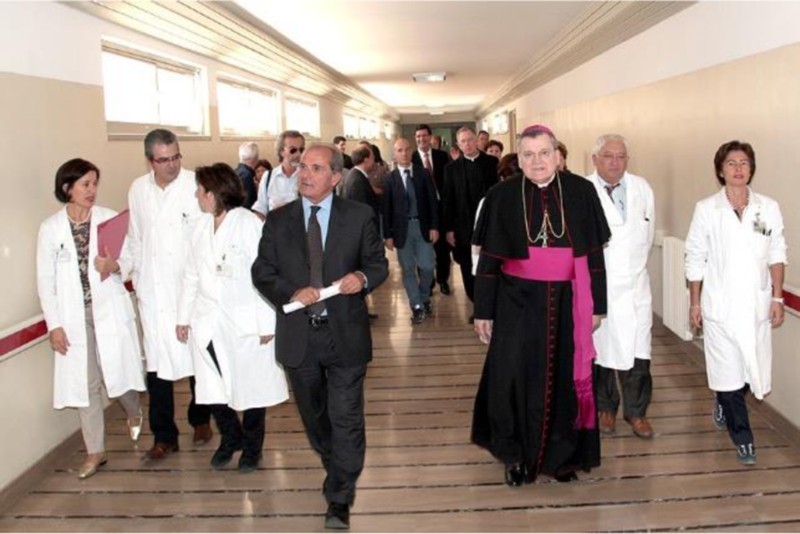
The leadership of CHI, under the episcopal guidance of His Eminence Raymond Leo Cardinal Burke, foresaw the current crisis in Catholic health care, and adopted the prophetic statement of Dr. Sanguinetti as its vision. CHI commenced immediately to pursue a formal collaboration agreement with the Vatican-owned hospital established by St. Pio, to replicate it as a model of faithful Catholic health care in a secular world—a “Beacon of Light”—to be emulated in the United States and other areas of the world. As Cardinal Burke stated, “How much we need the beacon of sure and enduring hope offered by the Home for the Relief of Suffering!” (Burke 2012, 12).
After a series of meetings between the leadership of CHI and the Casa, an inspirational program was held at San Giovanni Rotondo, Italy on October 1, 2009, at which a formal Collaboration Agreement was executed between the two parties (Catholic Healthcare International 2010). Both entities agreed to join forces to implement this vision as the vehicle to guide Catholic health care back to its fundamental roots in the charism of St. Pio and the model he developed. Cardinal Burke prayed this blessing upon the initiative,
May the Holy Spirit give to the leaders of Catholic Healthcare International and all who work with them a generous portion of the spirit of Saint Pio of Pietrelcina, the spirit which is alive and active in the Home for the Relief of Suffering. (Burke 2012, 12)
The Casa USA Model—The Three Pillar Program
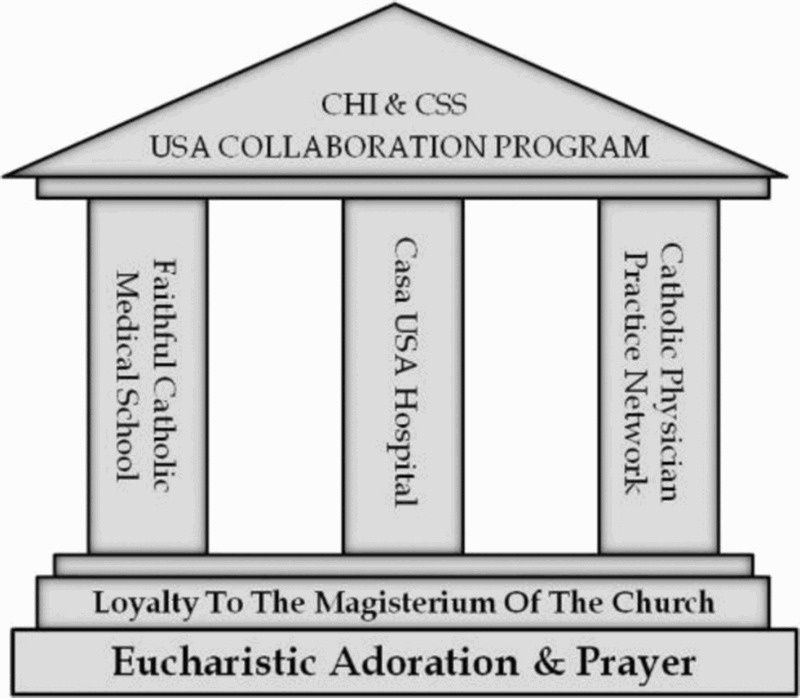
The aforementioned overview provides the context in which the board and leadership team of Catholic Healthcare International began to pursue the implementation of its collaborative vision with Padre Pio's Casa. A “Three Pillar Program” was developed which encompasses the essential components to achieve the comprehensive objectives of the CHI Casa USA vision. First and foremost, as was insisted by St. Pio himself, this initiative must be built upon the solid foundations of prayer and loyalty to the Magisterium of the Roman Catholic Church. The US Padre Pio Prayer Groups were enlisted to provide continuous prayerful support, and Fr. Francis Sariego, OFM Cap., the national coordinator of the US Prayer Groups, was added to the CHI board of directors. His Eminence Raymond Cardinal Burke, a staunch advocate of Church orthodoxy, accepted the role of episcopal moderator for CHI. Additionally, a commitment was made by the board of directors to incorporate Perpetual Eucharistic Adoration in each Casa hospital developed by CHI. It is well documented that dioceses, religious congregations, ministries, apostolates, parishes, etc., and the initiatives they pursue, that are supported by vibrant Eucharistic Adoration programs, thrive as a result of the abundant graces emanating from this unparalleled devotion to the Real Presence of Jesus Christ.
The initial Casa USA will incorporate all three pillars in a single comprehensive campus. Each pillar of the Casa USA program will serve both the faithful and those in need of relief of suffering, and will also stand as a model and “Beacon of Light” to be emulated and replicated by other Catholic healthcare providers seeking to incorporate this same vision. Network systems will be established for the disciplines of each of the three pillars, encouraging affiliation status to other like entities provided they meet pre-established criteria warranting excellence in quality and faithfulness to the Magisterium of the Church.
The first pillar of the Casa USA program is the establishment of a truly faithful Catholic physician practice network. In this secularized world, Catholic physicians are feeling pressure from numerous sources attempting to dictate how they practice medicine and care for their patients. Often these influences are inconsistent with our Catholic values. These model practices, in addition to serving the needy in the charism of St. Pio, will be a resource to Catholic physicians to help guide them in establishing individual practice models built upon values consistent with Catholic teachings and doctrine, and faithful to the Magisterium of the Church.
The second pillar of the program is the replication of the Casa Sollievo della Sofferenza hospital in the United States. The US Casa will adopt the same name and emulate the charism, structure, organization, operation, and all aspects—even the exterior façade—of Padre Pio's Casa in Italy. This will be a teaching hospital, affiliated with the Casa in Italy, and sharing numerous exchange programs. Like the model Casa USA physician practices, this model Casa hospital will stand as a beacon and serve as a model for other Catholic hospitals to emulate, and to which they can affiliate if they are committed to the established Casa criteria.
The third pillar is the development of a truly faithful Catholic medical school to provide formation of physicians and ancillary healthcare professionals to practice as faithful Catholics in this ever more secular country of ours. Many Catholic religious and healthcare professionals believe that most existing Catholic medical schools lack unwavering Magisterial faithfulness, and some contend that in reality they are only nominally Catholic. In addition to providing orthodox formation to Catholic medical students and physicians, this uniquely Catholic medical school and Casa hospital will serve as a welcome respite of continuing education and retreat for Catholic healthcare providers to revitalize their spirit, body, and professional skills, and arm them to return as faithful witnesses in their local secular communities.
Seven Guiding Elements for Catholic Health Care in a Secular World
At its collaborative retreat at Rome in October 2012, Cardinal Burke outlined “seven elements” to the leaderships of CHI and the Casa Sollievo della Sofferenza in Italy to guide Catholic healthcare institutions in meeting the challenges of the future in a secular world. These very profound and insightful principles are summarized below because of their abounding contemporary relevance to the challenges confronting religious and healthcare leaders in our society. The board of directors of CHI has incorporated them as its guiding principles in the pursuit and implementation of its vision. Readers of this article will surely find His Eminence's complete treatise valuable and rewarding, and are encouraged to consider it seriously in their professional pursuits. A summary of the elements proposed by Cardinal Burke are as follows:
Element 1. “An … understanding of what it means to be Catholic, and of the importance of providing health care in accord with the teaching, worship, and governance of the Catholic Church.”
Element 2. “The knowledge [of] and commitment to a distinct form of health care, namely the care of the sick and dying in the Church, as an integral part of the Church's mission under the direction of the diocesan bishop and ultimately the Roman Pontiff.”
Element 3. “The personal commitment of the administration and staff of the Catholic healthcare institution to the Church's teaching, to carrying out the care of the sick and dying after the mind of Christ alive for us in the Church.”
Element 4. “A Catholic understanding of man which inspires the care of the whole person … [which] must see the physical and emotional difficulties of the person within the context of his moral and spiritual life.”
Element 5. “The priority of ethical and religious standards over professional standing and position within the larger medical community. The desire to have the approval of prominent secular institutions can never justify the compromise of ethical and religious principles. The Ethical and Religious Directives for Catholic Health Care Services must be viewed as the binding norms.”
Element 6. “Freedom from financial support and assistance which is given under conditions which obscure or even betray the Catholic identity of the Catholic healthcare institution.”
Element 7. “The discipline of the desire for credibility or prestige which would lead the Catholic institution into relationships with large, non-Catholic healthcare institutions by way of mergers, partnerships, or joint ventures” (Burke 2012, 7–10).
Casa USA: The First Fruits
Giving the benefit of your charity to all without distinction, from the most well-off to the poorest, administering to all, in generous measure.—Padre Pio
On October 24, 2011, the directors of Catholic Healthcare International completed construction and opened the doors of Casa San Pio Medical Clinic, a completely new and state-of-the-art comprehensive outpatient medical facility situated in the extremely poor and underserved region of Appalachia in rural Kentucky (Casa San Pio Medical Clinic 2015). Not only was Casa San Pio built to serve those in need of relief of suffering in Appalachia, it was also established as a model to be duplicated on the Casa USA campus once its location is confirmed. In keeping with the commitment to loyalty to the Magisterium of the Church, the bishop of the local diocese was involved from its opening, and in fact was an integral part of the team which discerned that the ownership of the clinic should be transitioned to this mission diocese.
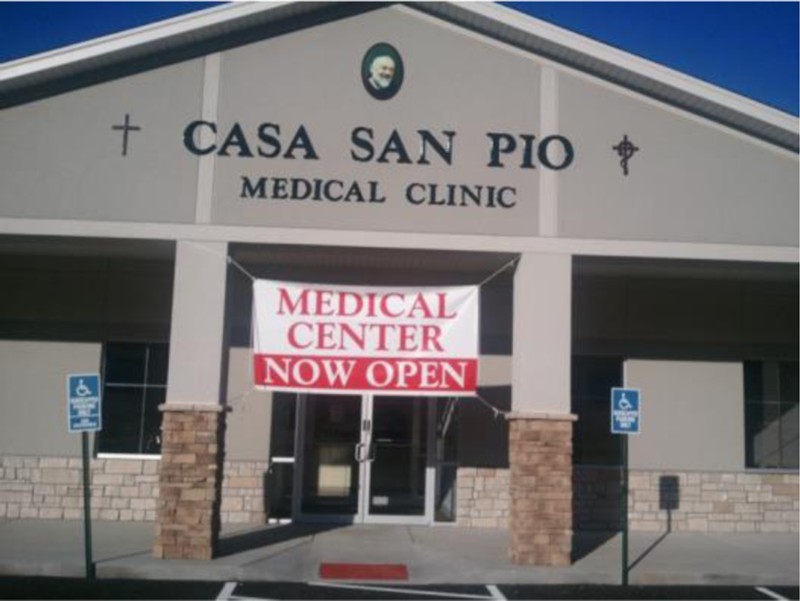
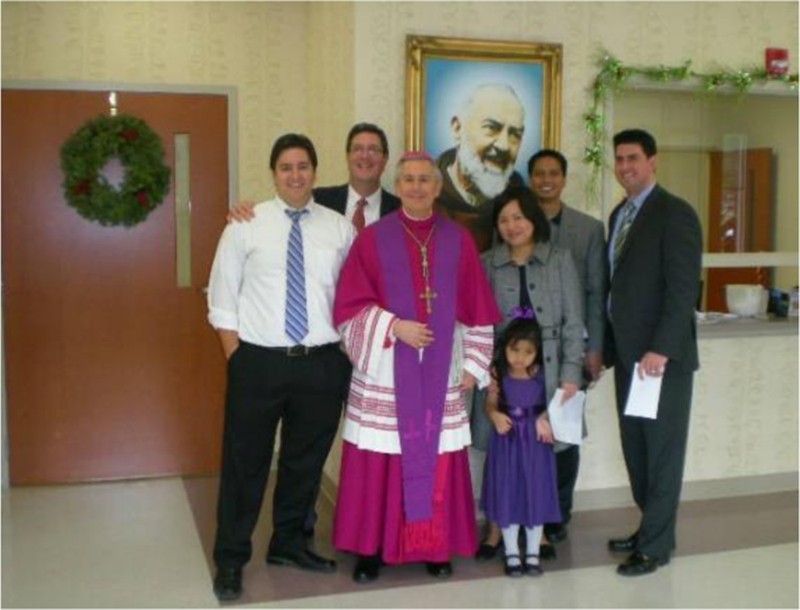
On July 1, 2013, Casa San Pio of Appalachia formally became an apostolate of the Roman Catholic Diocese of Lexington, and is now wholly owned and operated by the diocese and its bishop. This was a very unique transition, and it is living testimony to CHI's commitment to discerning and following the will of the Holy Spirit and obedience to the Church in all of its initiatives.
In addition to comprehensive medical care, Casa San Pio continues to provide highly technical services including CAT scans, ultrasound, stress tests, X-ray, laboratory, and a fully electronic medical record system—state-of-the-art services to the poorest of the poor, those in need of relief of suffering. This fully Catholic medical clinic was the first fruits of the collaboration agreement, executed between Catholic Healthcare International and Padre Pio's Casa hospital in Italy, to duplicate Padre Pio's model of faithful Catholic healthcare delivery in the USA.
The Future of the Vision
The establishment of Catholic Healthcare International, its vision, and the collaboration agreement between CHI and the Casa Sollievo della Sofferenza in Italy were all the result of a personal inspiration by St. Pio of Pietrelcina and the desire of everyone involved to discern and follow the will of the Holy Spirit for them with childlike faith. The leadership team is convicted to doing God's will, in His time, and to giving Him the honor and glory as He cares for those in need of relief of suffering through simple but willing instruments. The Holy Spirit and St. Pio have been abundantly faithful, and great fruits have already been borne as a result because a few have answered the call. Sites are currently under evaluation for the next phase of the vision, which will be development of the comprehensive Casa USA campus and implementation of the Three Pillar Program. Great interest continues to be expressed by religious, healthcare, and education leaders to participate. Once the will of the Holy Spirit has been fully discerned, plans will commence to bring this inspired vision to reality. Ongoing updates regarding the activities of Catholic Healthcare International and its Casa USA vision may be found on its website at www.chi-usa.com.
This evening my earthly Work has begun. I bless you and all those that will contribute to the Work which will become bigger and more beautiful.—Padre Pio
Biographical Note
Jere Palazzolo has over thirty years of executive experience in the delivery of health care, and is the founder and president of Catholic Healthcare International and Marian Medical Services. Inspired by the “Work” and charism of St. Pio of Pietrelcina, Mr. Palazzolo facilitated a formal collaboration agreement with St. Pio's hospital, owned by the Vatican, to replicate it in the United States as a model of truly faithful Catholic healthcare delivery in a secular society.
References
- “A Short Biography of the Saint from Pietrelcino” 2009. L ‘Osservatore Romano (English), June 24.
- Burke Raymond Leo Cardinal. 2012. “The Catholic Identity of Catholic Hospitals in an Age of Secularization.” Catholic Healthcare International Leadership Retreat, Santa Maria Alle Fornaci, Rome, September 13.
- Casa San Pio Medical Clinic, Diocese of Lexington 2015. http://www.cdlex.org/index.cfm?load=page&page=716.
- Catholic Health Association of the United States (CHAUS) 2016. “Facts & Statistics—Catholic Health Care in the United States.” http://www.chausa.org/about/about/facts-statistics.
- Catholic Healthcare International 2010. “Collaboration Fact Sheet.” http://www.chi-usa.com/wp-content/uploads/2010/01/Collaboration-Fact-Sheet-0622121.pdf.
- La Casa Sollievo della Sofferenza newsletter 1950. July.
- Leone Gherardo. 1986. Padre Pio and His Work. San Giovanni Rotondo, Italy: Casa Sollievo della Sofferenza; English edition. [Google Scholar]
- Obama Barack. 2015. “Remarks by the President at the Catholic Health Association Conference.” Washington, DC, June 9. http://www.whitehouse.gov/the-press-office/2015/06/09/remarks-president-catholic-health-association-conference.
- Padre Pio Prayer Groups USA 2016. http://www.pppg.org.
- United States Conference of Catholic Bishops (USCCB) 2009. Ethical and Religious Directives for Catholic Health Care Services, 5th ed Washington, DC: USCCB. [PubMed] [Google Scholar]


